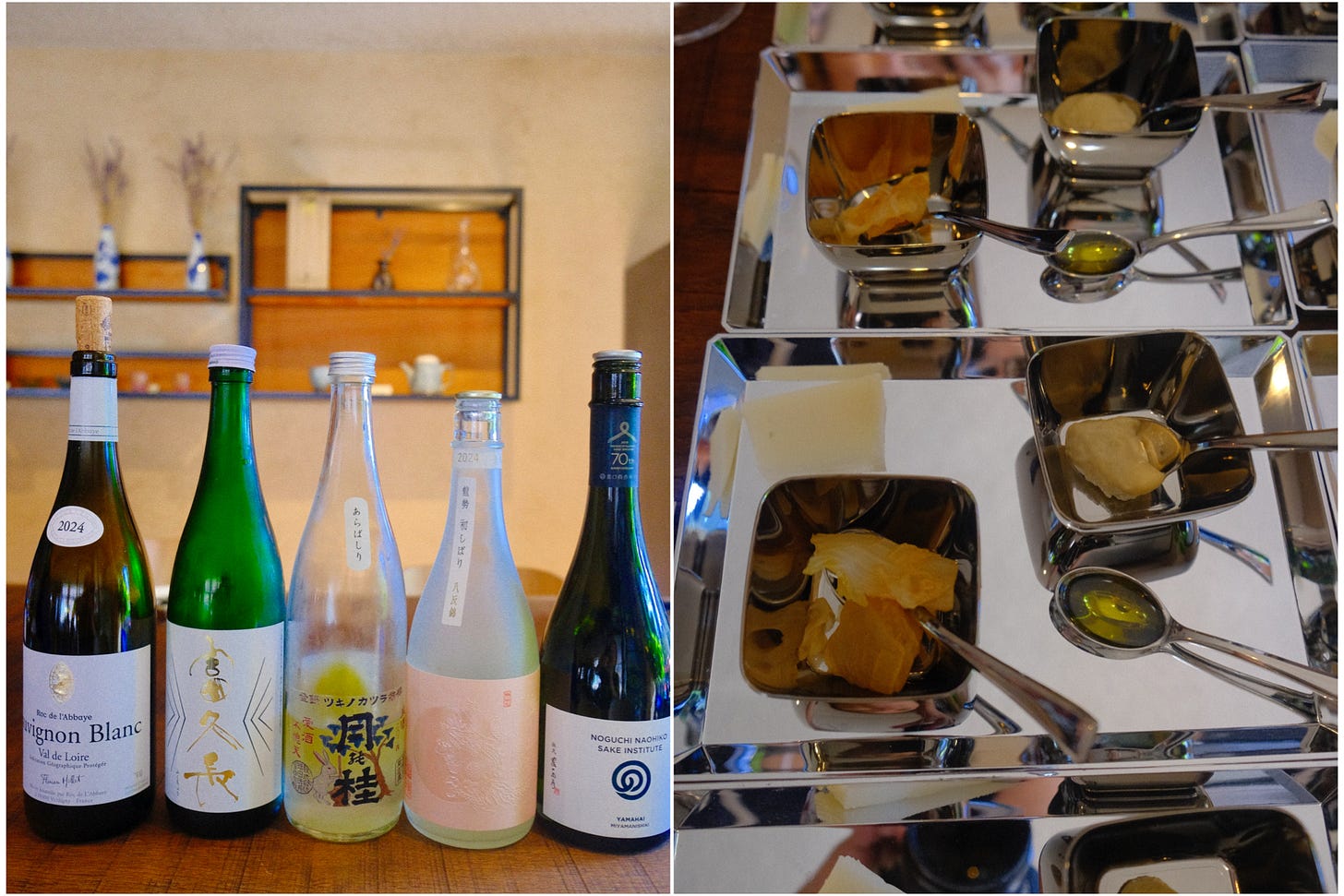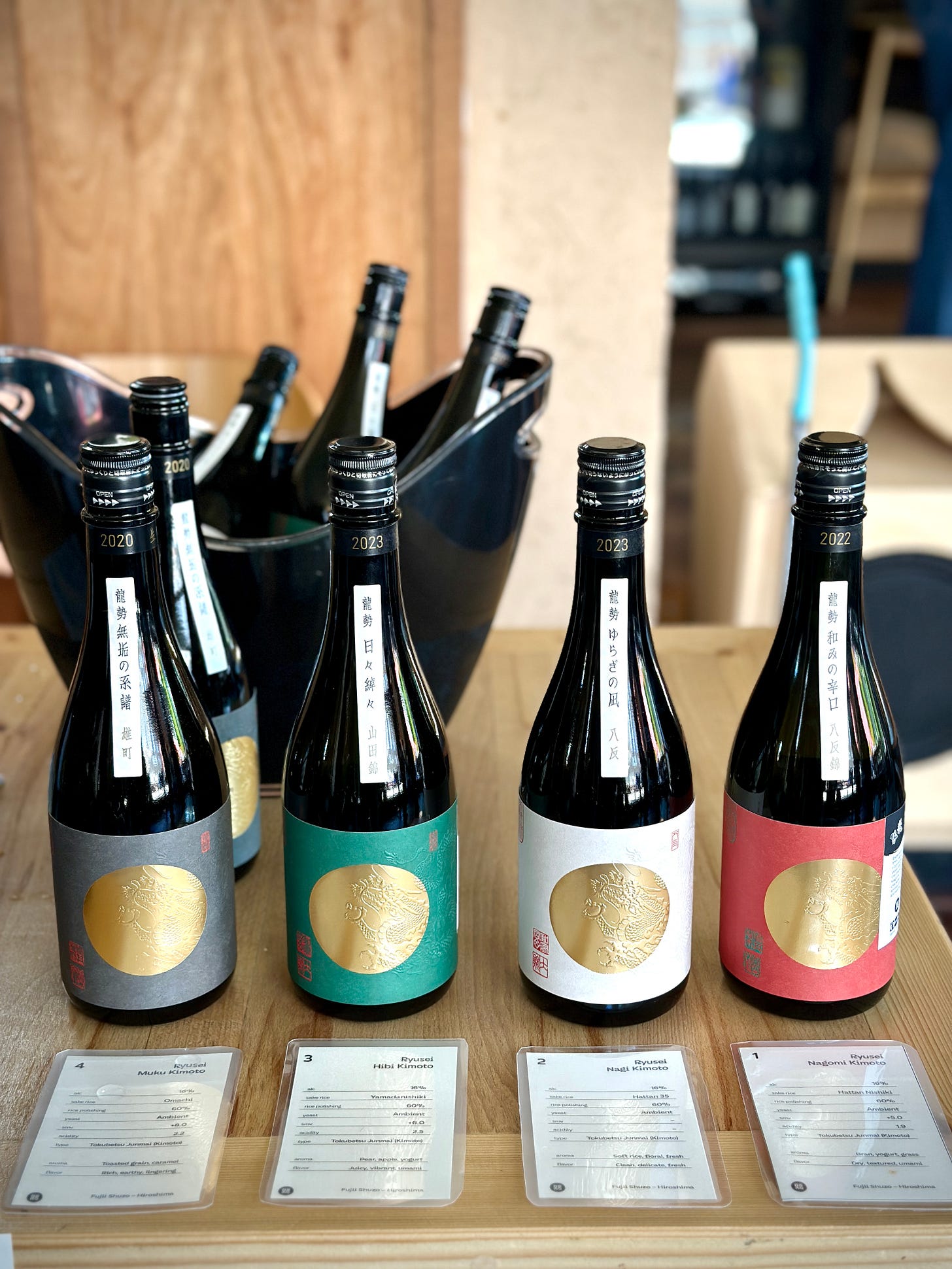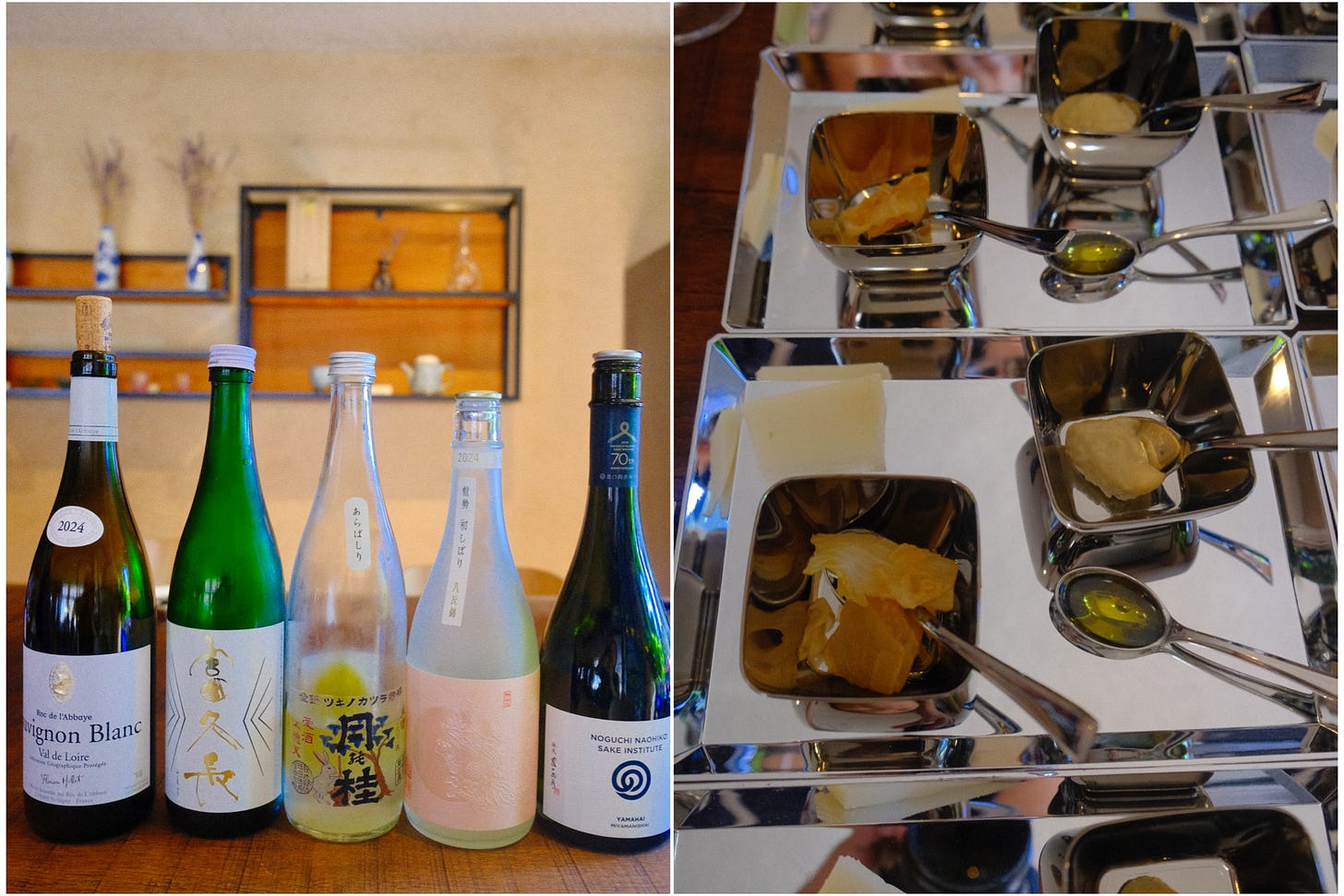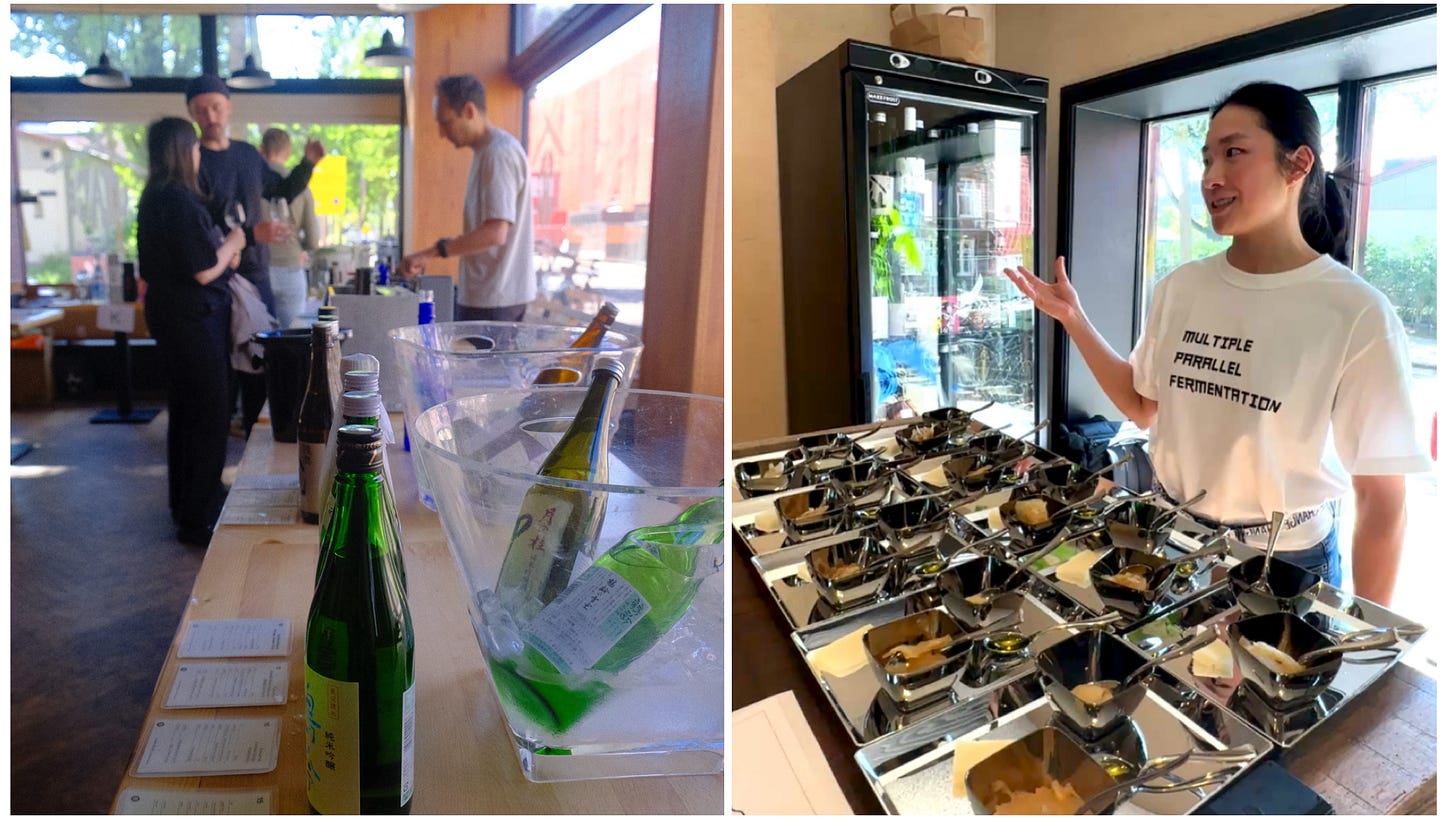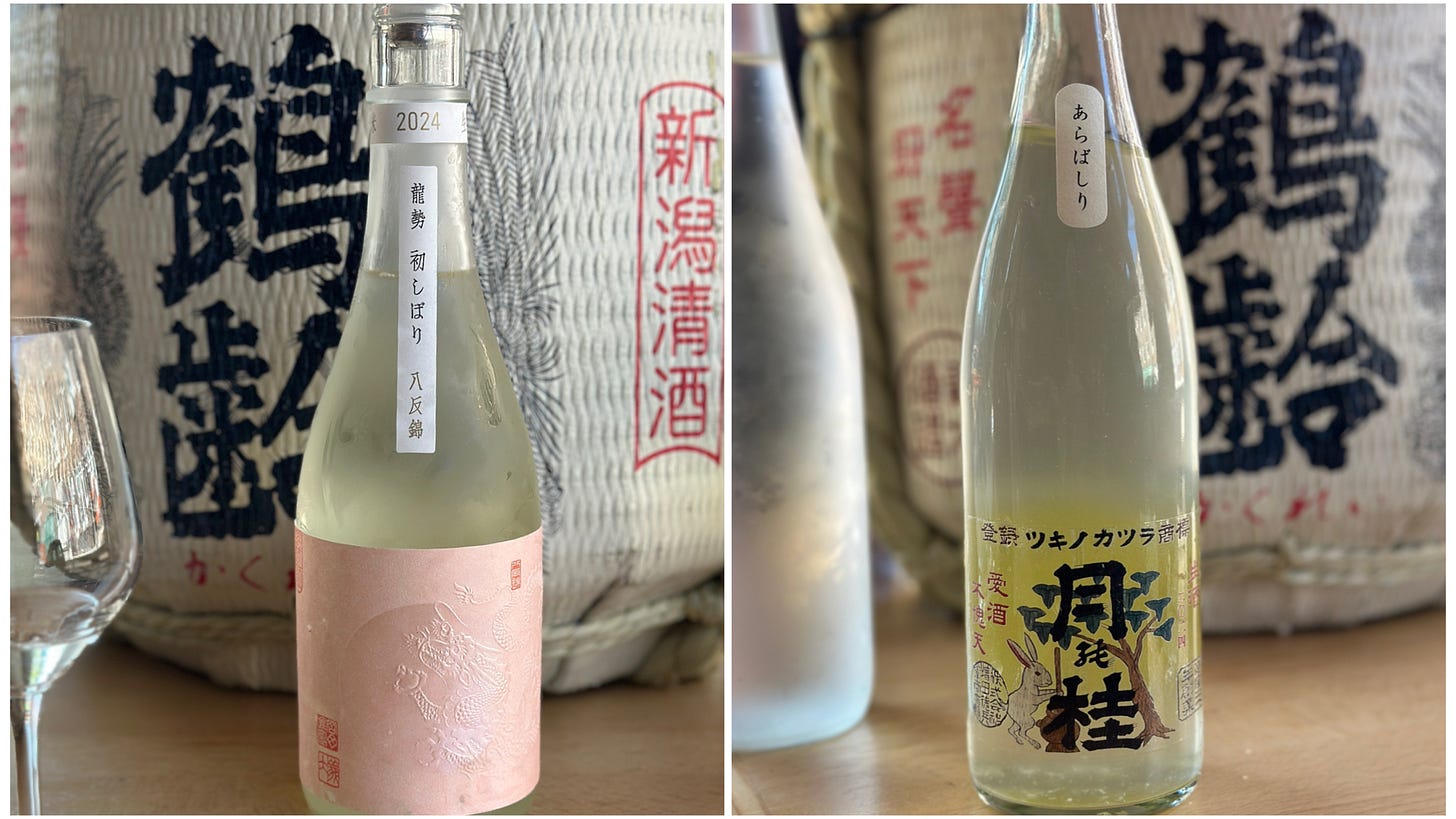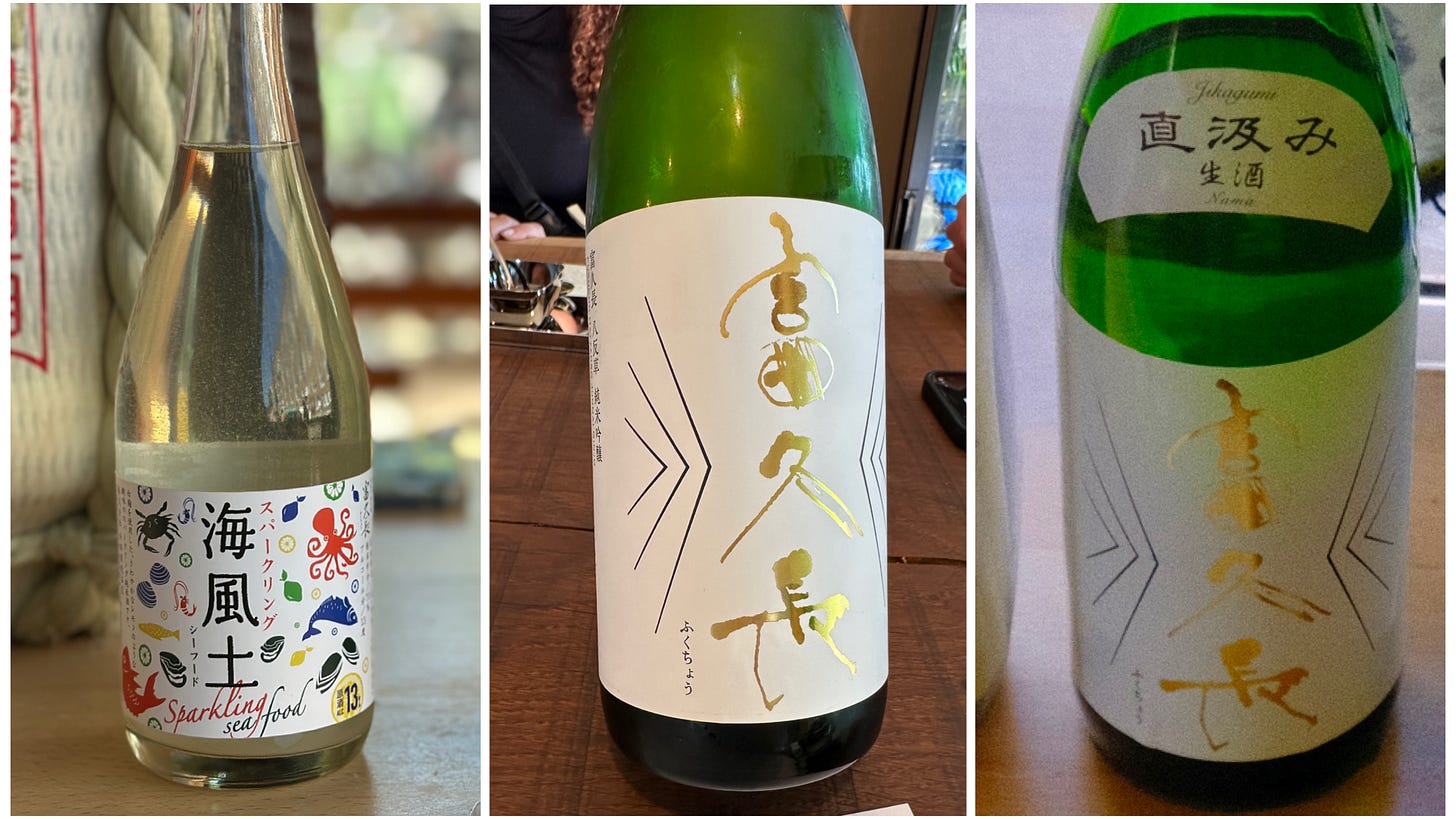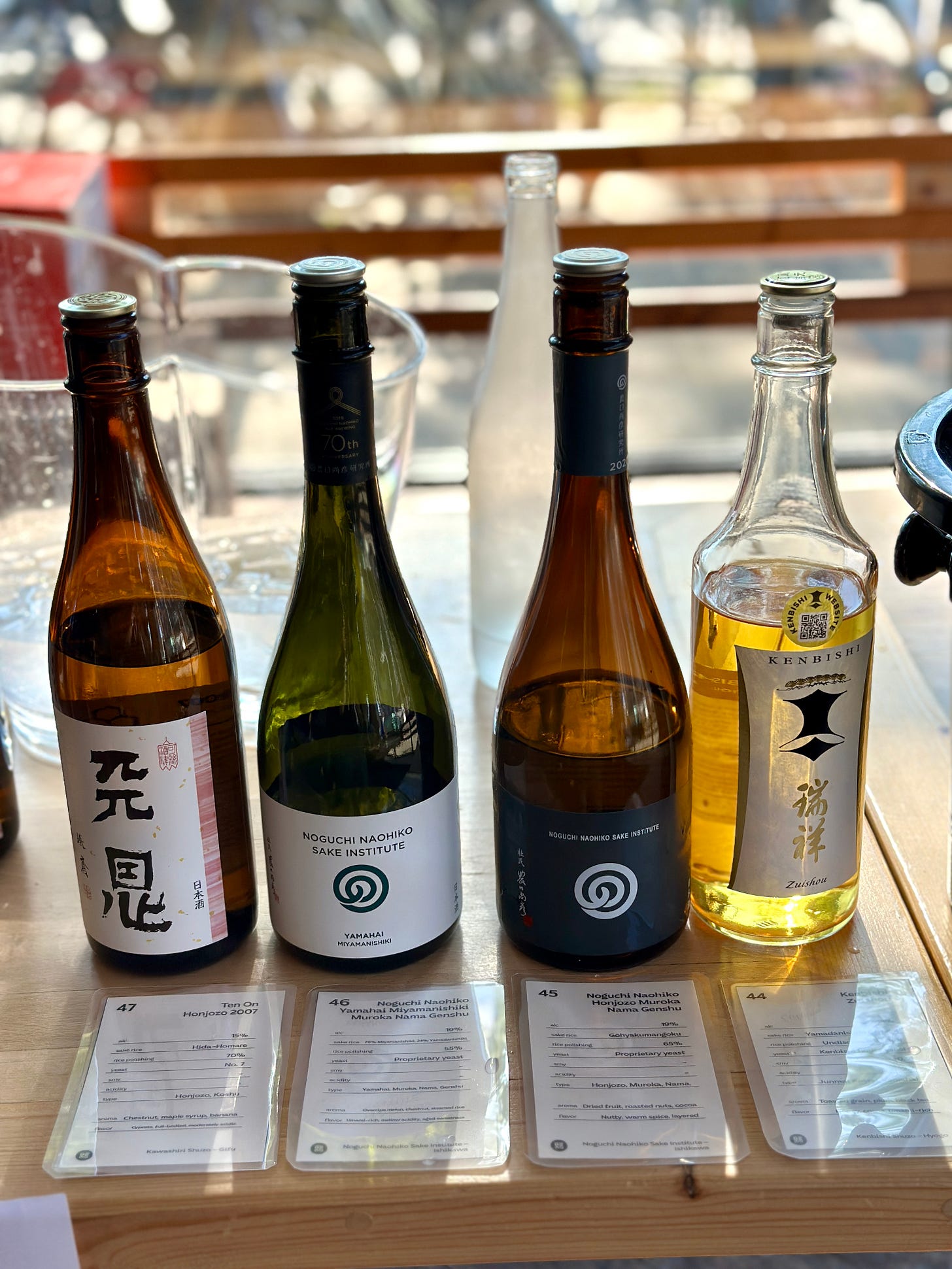Sake 101: Lessons from a Pairing Masterclass—Sake Meets Western Food
New Sake Pairings for Wine Pros: What a Masterclass Revealed About Flavor Matching
📍Who This Is For
If you're a wine buyer looking to expand your sake selection, a sommelier seeking confident recommendations, or a tasting leader who wants to explain sake with the clarity of a WSET grid—this post is written for you. Even if you're simply sake-curious, you'll come away with new ways to connect flavors and explain sake in wine terms.
Kazumi here—DipWSET-certified sake and wine educator based in Amsterdam, helping wine professionals translate the world of sake through a language they already know. With a background bridging Japanese fermentation and European wine education, I explore how these worlds overlap at the table.
Ever wondered how Ginjo sake might handle goat cheese better than Sauvignon Blanc? Or how a Nama sake can tame the funk of kimchi?
In mid-May, I attended a sake masterclass organized by a premium Japanese sake importer based in the Netherlands, Otemba Sake Amsterdam together with their portfolio tasting. The masterclass session was led by Isabelle Chow, a sommelier with professional training in both wine and sake, who now works at her family’s Japanese restaurant, Akitsu.
After a brief overview of Sake 101, she began drawing parallels between wine and sake styles with the WSET wine aroma and flavor lexicon. By translating familiar wine categories into their sake equivalents, she offered a deeply intuitive and culturally fluid approach to understanding sake. It was the kind of crossover thinking I also seek to. So in this post, I’ll share a guided perspective through her lens: translating wine profiles into sake styles—and how that opened up new Revelatory pairing possibilities we hadn’t expected.
Lexicon Parallels: Wine vs. Sake
Isabelle’s greatest insight in the session was demonstrating that wine and sake aren’t mutually unintelligible—they simply speak different dialects of the same sensory language. The sources are different, yet both express similar aromas.
In wine, fruity aromas emerge from fermentation driven by aroma precursors in grape must, such as thiols and terpenes. For instance, thiols like 4MMP give Sauvignon Blanc its distinct box tree scent, while terpenes like linalool and geraniol produce the characteristic grapey notes in Muscat. In contrast, sake achieves its fruity aromas primarily through yeast metabolism during fermentation, especially prominent in Ginjo-style Japanese sake, where fruity and floral esters such as ethyl acetate and isoamyl acetate generate aromas reminiscent of banana, apple, melon, pear, lychee, pineapple, cherry, blossom, lily, and rose.
The lactic notes in wine result from malolactic fermentation (MLF), which converts sharp malic acid into smoother lactic acid, imparting buttery, creamy, or yogurt-like flavors. In sake, lactic notes arise naturally through the Yamahai or Kimoto brewing methods, where prolonged fermentation and ambient microbes produce a comparable dairy characteristic, albeit structurally distinct.
Tertiary or oxidative notes in wine emerge through bottle or barrel aging, bringing forward complex aromas like mushrooms, nuts, and dried fruit. In sake, similar characteristics appear in Koshu (aged sake) or intentionally oxidative brewing methods. The shared chemical reaction—Maillard reaction—between amino acids and reducing sugars results in the production of the compound sotolon, imparting aromas of walnuts, curry leaf, and maple syrup.
Of course, sake uniquely offers aromatic notes rarely found in wine. Grain- and sweetness-derived aromas such as steamed rice, cereal, rice bran, cotton candy, brown sugar, and sugarcane create textural, nostalgic layers distinctively different from fruit-driven wine aromas.
Translating Wine Preferences into Sake Styles
Isabelle guided us through distinct and bold translation models, effectively bridging familiar wine preferences with sake styles.
For lovers of aromatic whites like Sauvignon Blanc, Grüner Veltliner, Albariño, or Sylvaner, sake offers a compelling parallel through the fruity Ginjo style. The production process also plays a crucial role. Ginjo aromas flourish at controlled low temperatures, which also helps reduce off-flavors and allows for more precise fermentation control, resulting in sophisticated and elegant style. Certain yeast strains are especially known for crafting exceptionally aromatic profiles, often proudly noted on bottle labels.
Additionally, Japanese culture deeply values freshness, which has inspired vibrant seasonal sake expressions—akin to the excitement of Beaujolais Nouveau, but celebrated more frequently throughout the year by crafting specific styles. Examples include freshly pressed sake offering a bright and lively taste reminiscent of fresh juice (Shiboritate), lower-alcohol, crisp sake ideal for beating summer heat (Natsuzake), and mellow, rounded sake matured over summer and released in autumn, perfect for seasonal dishes (Hiyaoroshi).
Those who favor crisp whites such as unoaked Chablis or Rieslings without malolactic fermentation or oak influence—marked by pronounced malic acidity—will find an appealing counterpart in sake crafted with white kōji. Traditionally associated with shōchū, white kōji mold (Aspergillus kawachii) now increasingly features in sake brewing, notably by breweries such as Imada Shuzo. Certain yeast types or strains isolated from apple blossoms further enhance this crisp, lively acidity reminiscent of fresh, fruit-forward white wines.

For enthusiasts of oxidative or savory whites, drawn to wines like Amontillado, Vin Jaune, Oloroso, or Madeira, sake offers a fascinating alternative through aged koshu styles. Though starting from a very different base of rice and kōji mold, koshu undergoes a similar transformative Maillard reaction—interactions between amino acids and reducing sugars—to develop rich aromas of caramel, soy sauce, toasted grains, and roasted nuts.
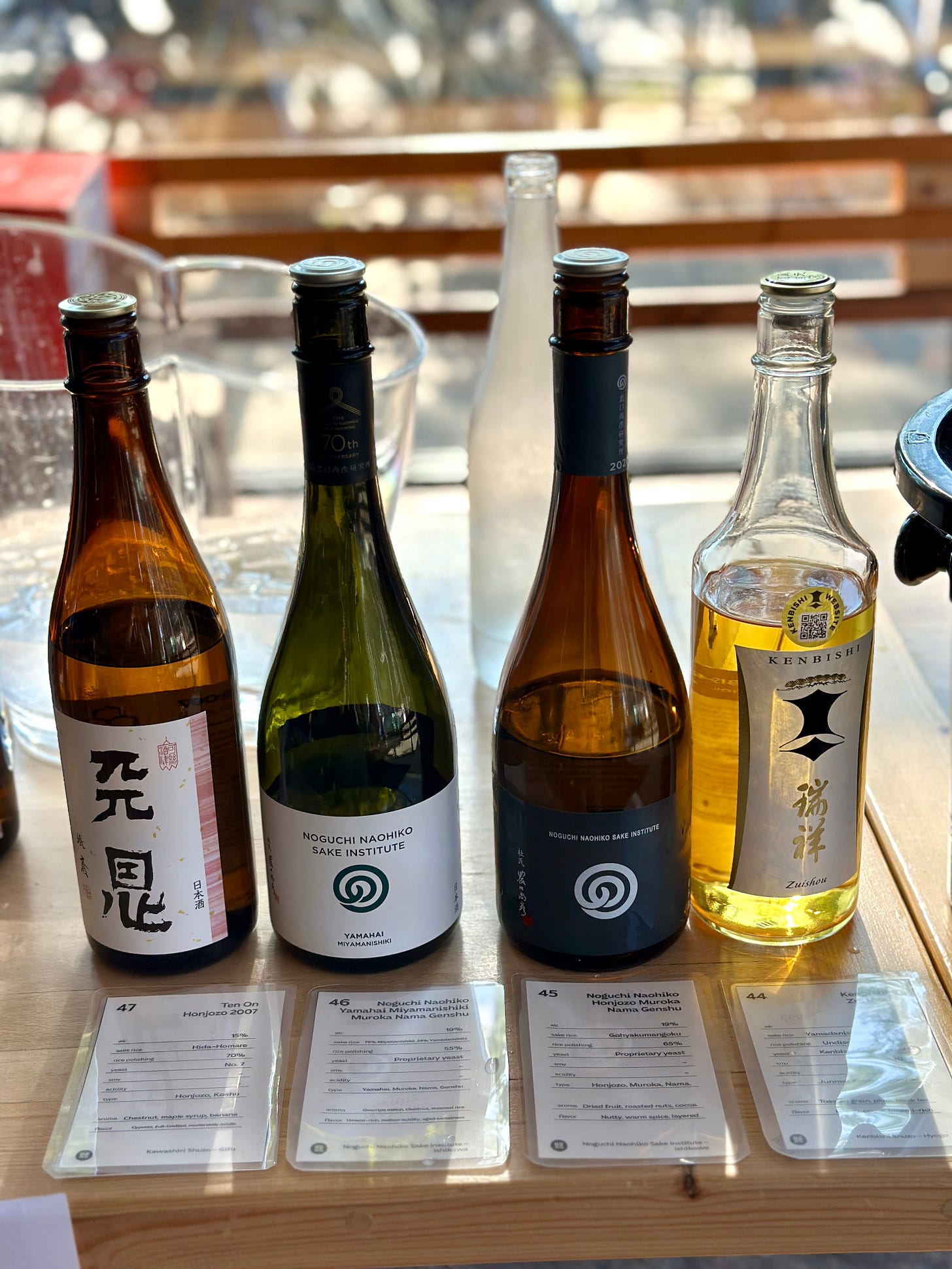
Additionally, umami-rich, layered Yamahai and Kimoto sake styles also resonate strongly with these savory wine preferences, offering intriguing depth and complexity.
Four Revelatory Pairings

Fukucho Hattanso Junmai Ginjo – Imada Shuzo, Hiroshima
Rice: Hattansō
Polishing Ratio: 50% (koji), 60% (kake)
Alcohol: 16%
Type: Junmai Ginjo
On its own, this sake showed soft, gentle texture with a remarkably clean aftertaste—a unique feature of the rare, ancient rice Hattansō. Its Ginjo aroma delivered balanced fruit and umami tones with hints of banana and apple.
When paired with Sauvignon Blanc, the goat cheese’s tang and citrusy brightness played beautifully together. But with Fukucho Junmai Ginjo, the acidity is positively softened, and the cheese’s sharpness was gently wrapped in umami—the sake didn’t contrast so much as cradle the flavor, creating a more rounded harmony. This pairing reminded me that acidity isn’t the only tool for pairing—umami and amino acids also play a key role.
Tsuki no Katsura Junmai Ginjo Nama Arabashiri – Masuda Tokubee Shoten, Kyoto
Rice: Gohyakumangoku
Polishing Ratio: 55%
Alcohol: 17%
Type: Junmai Ginjo, Nama, Arabashiri
The hummus had a mellow texture with earthy, nutty flavors. On its own, this unpasteurized and unfiltered sake showed vibrant freshness, a touch of effervescence, and a yogurt-like tang balanced by subtle bitterness. Paired with the hummus, its crisp energy cut through the richness, lifting and brightening the dish’s savory notes. Arabashiri’s lively texture made it a perfect introduction to the fresh charm of seasonal sake.
Ryusei Shiboritate – Fujii Shuzo, Hiroshima
Rice: Hattan Nishiki
Polishing Ratio: 60%
Alcohol: Not specified
Type: Junmai, Nama, Shiboritate, Kimoto
On its own, this freshly pressed Kimoto-style sake showed bold acidity and deep umami, with bright notes of green apple, melon, and grape, all wrapped in a feisty, unpasteurized edge. Paired with spicy, fermented kimchi, it struck a remarkable harmony—the kimuchi didn’t overpower but danced alongside the flavors of sake, taming the heat and amplifying complexity. A rare case of fermentation meeting fermentation—not with friction, but with perfect synergy.
Noguchi Naohiko Yamahai Miyamanishiki – Noguchi Naohiko Sake Institute, Ishikawa
Rice: 76% Miyamanishiki, 24% Yamada Nishiki
Polishing Ratio: 55%
Alcohol: Not specified
Type: Yamahai, Muroka, Nama, Genshu
This is a powerhouse of a sake—unfiltered, unpasteurized, undiluted—with bright citrus and botanical aromas layered over melon, lychee, spice, rice brain, and a touch of herbal bitterness. High alcohol (19%), with rich umami and a saline, mineral core anchored the wine-like complexity.
Paired with truffle oil, this was a textbook case of earthy depth meeting savory resonance. The umami echoed the truffle’s depth, and the acidity balanced the intensity.
Sake as a Complement, Not a Substitute
This session reaffirmed a truth I keep returning to: sake and wine may come from different traditions, but they share deep common ground—especially in how they engage with food. Both fermented, both expressive, both versatile. But sake’s strength lies not in replacing wine, but in expanding the conversation around flavor and pairing.
What stood out in this tasting was not only the classic aromatic elegance of Ginjo-style sake, but also the range of styles that go far beyond it: sharp, citrusy sakes brewed with white kōji; unfiltered, unpasteurized, undiluted powerhouses; seasonal releases brimming with vibrancy; and extreme, competition-level sake designed for clarity and finesse. Together, they represent a landscape just beginning to be explored in the context of European ingredients and modern pairing strategies.
Isabelle’s framing—starting with a wine style, then asking what kind of sake shares its key sensory traits—felt like a bridge between two worlds. Thinking about sake not as a substitute, but as a complement to wine, opened up entirely new possibilities. And in tasting pairings like truffle with Yamahai or kimchi with Shiboritate, I was reminded of just how deep sake’s range goes.
Whether it's goat cheese, fermented vegetables, or rich umami-laden sauces, sake has the structure and generosity to meet them. Not as a stand-in for wine, but as its counterpart—sometimes gentle, sometimes bold, always full of potential. This is a dialogue worth continuing, and one I’m excited to keep exploring.
Many thanks to Isabelle and the Otemba Sake team for the invitation and for sharing your thoughtful insights.
📌 Let’s Trade Notes
Did anything in this story make you curious about sake? Whether you're new to it or looking to deepen your knowledge, I’d love to hear what sparked your interest. Leave a comment or reply.
This post is part of my Tuesday Sake 101 series, where I explore the foundations of sake through a wine-savvy lens. It pairs with my Friday pairing series, where I share unexpected food & wine (or sake) combinations from across Asia and beyond.
👉 If you found this useful, subscribe to get each week’s edition in your inbox—and feel more confident recommending sake at your shop, bar, or table.
Thanks for reading Pairing the World: Wine, Sake, and More!
Sake 101: 四つのペアリング ワインのプロに向けた新しい日本酒の提案
──あるマスタークラスが教えてくれた、香りと食の架け橋
📍この投稿の意図
オランダ・アムステルダム在住の日本酒とワインの講師、Kazumi(DipWSET)です。
この投稿は、海外のワインのプロフェッショナル——たとえば、ワインショップのスタッフ、ソムリエ、ワインエデュケーターといった方々に、日本酒の魅力をもっと知ってもらいたいという思いから英語で執筆しています。
日本とヨーロッパ、両方の食文化を背景に、
「日本酒やワインの魅力を自分の言葉で伝えられるようになりたい」
「日本と海外の架け橋になりたい」
そんな願いを込めています。
この日本語訳は、その取り組みを日本の皆さまに知っていただくために添えています。
今回は、オランダのプレミアム日本酒のインポーターが開催した、ポートフォリオテイスティングと、ペアリングのマスタークラスの様子をまとめました。欧州で日本酒がどのように紹介されているかの一面を知っていただけると思います。
たとえば──吟醸酒はソーヴィニヨン・ブランよりも山羊のチーズと合う? 生酒はキムチの“クセ”を抑え込む?
そんな問いの答えを探るきっかけとなったのが、5月中旬にオランダのインポーター、Otemba Sake Amsterdamが開催したマスタークラスおよびポートフォリオ・テイスティング。講師はイザベル・チョウ氏。ワインと日本酒の両方で訓練を積んだソムリエで、現在はご家族が営む日本料理店「秋津」で活躍されています。
講座では、冒頭に日本酒の基礎をさっとおさらいしたあと、WSETのワイン用語を使って、ワインスタイルと日本酒スタイルの間にある「香りと言語の架け橋」を紹介してくれました。たとえば「マロラクティック発酵由来の乳酸感」と「山廃仕込みの酸(山廃=生酛系の製法で自然乳酸菌を使う)」、あるいは「熟成による三次アロマ」と「古酒や酸化的な醸造法で造られた酒」──それらの対応関係を知ることで、日本酒がいかにワイン的に語りうるかが一気に見えてきます。
まさに私自身が探している「クロスオーバーな思考」そのものでした。今回の記事では、イザベルの視点を借りながら、ワインのプロが日本酒をどう読み替えられるか、そのプロセスをたどっていきます。そしてそこで出会った、四つのペアリング体験もご紹介します。
■ワインと日本酒、香りの共通語彙
今回のマスタークラスで最も印象的だったのは、「ワインと日本酒は別々の言語を話す存在ではない」という示唆でした。むしろ、同じ“香りの言語”を異なる方言で語っているようなものだと、イザベルは言います。
ワインにおいて果実香は、ぶどうに含まれるたとえばチオールやテルペンといったアロマ前駆体が発酵によって変化することで生まれます。たとえば、ソーヴィニヨン・ブランのツゲの香りは4MMPというチオール由来、マスカットの華やかさはリナロールやゲラニオールといったテルペン由来です。これに対し、日本酒の果実香は主に酵母由来のエステル(酢酸エチルや酢酸イソアミル)によって構成され、とくに吟醸系スタイルにおいてバナナ、青リンゴ、メロン、洋梨、ライチ、パイナップル、さくらんぼ、花やリリーといった香りが立ち上がります。
乳酸系の香りは、ワインではマロラクティック発酵(MLF)によって、シャープなリンゴ酸がまろやかな乳酸に変わり、バターやクリーム、ヨーグルトといった風味をもたらします。日本酒では、山廃や生酛といった伝統的製法によって、自然発酵過程で乳酸菌が働くことで同様の乳製品系の香りが得られます(果実香と乳酸系の香、どちらも構造は異なっていても、香りの印象としては近い)。
三次アロマや酸化香についても同様の対比が可能です。ワインでは熟成や樽熟によってキノコ、ナッツ、ドライフルーツのような香りが現れますが、日本酒でも古酒や酸化的手法で仕込まれた酒に、ソトロン(クルミやカレーリーフ、メープルシロップを思わせる香り)など、同じ化学的変化が関与しています。
一方で、もちろん日本酒独自のアロマ世界もあります。米や糖由来の香り──蒸し米、シリアル、米ぬか──に加え、綿菓子、黒糖、サトウキビといった甘く懐かしい香りもそのひとつ。これらはワインではあまり出会えない、テクスチャーと記憶に訴える香りです。
■ワインスタイルから日本酒を読み解く
イザベルが示した次のステップは、「好きなワインスタイルから日本酒を選ぶ」という翻訳的アプローチでした。これは単なる“置き換え”ではなく、感覚的な接続点を探す試みです。
たとえば、ソーヴィニヨン・ブランやグリューナー・ヴェルトリーナー、アルバリーニョ、シルヴァーナーのようなアロマティックで軽快な白ワインが好きな人には、吟醸スタイルの日本酒がぴったり。吟醸香は、発酵温度を抑えてオフフレーバーを減らしながら、酵母が生成する香りを際立たせることで生まれます。協会酵母1801、1601などのアロマ系酵母がよく用いられ、香り高く、洗練されたスタイルに仕上がります。
また、アロマティックで軽快な日本酒の例として、季節酒も紹介されました。日本文化では「新鮮さ」が非常に重視されており、それが四季折々の「季節酒」としてリリースされます。たとえば、搾りたての生酒(しぼりたて)はまるで果汁のようにジューシーで爽快。夏には低アルコールでシャープな「夏酒(なつざけ)」が登場し、秋にはひと夏熟成された「ひやおろし」が落ち着いた旨味とともに楽しまれます。ボジョレー・ヌーヴォーのような旬を祝う感覚に近いものの、もっと頻繁に“旬”が訪れるのが日本酒の面白さでもあります。
次に、マロラクティック発酵や樽熟成を経ていない、シャープな酸をもつ白ワイン──たとえば樽なしのシャブリや若いリースリング──が好きな人には、白麹を使った日本酒が響く可能性が示唆されました。白麹は焼酎で用いられてきたものですが、近年では酒蔵によって日本酒にも応用され、酒にしっかりとした酸味をもたらします。広島の今田酒造のように、リンゴ酸を多く生む酵母や白麹を用いることで、フレッシュで果実味あふれる酸をもった酒が生まれています。
また、酸化熟成された白ワイン──たとえばアモンティリャード、ヴァン・ジョーヌ、オロロソ、マデイラ──のようなスタイルを好む方には、古酒(熟成酒)や酸化的製法の日本酒が新たな発見となるでしょう。日本酒は米と麹から作られますが、10年以上の熟成を経ることで、キャラメル、しょうゆ、トースト香、ローストナッツといった熟成香が現れます。これらはワインにおけるマイヤール反応と同様の化学反応によって生まれるものです。
さらに、山廃や生酛といった、乳酸を主体とする旨味重視の伝統的手法で造られた日本酒は、奥行きのある味わいと発酵感が魅力。欧州の熟成白ワインと同様、発酵のニュアンスが重層的に感じられるスタイルです。
■四つのペアリング体験
このマスタークラスで紹介された四つのペアリングは、日本酒のポテンシャルに対する私の見方を揺さぶるものでした。それぞれの酒が料理とどう交わり、どんな香味の橋を架けたのか──ここでは、その印象を振り返ります。
● 富久長 八反草 純米吟醸(今田酒造、広島)× フレッシュなゴートのチーズ
使用米:八反草(麹米50%、掛米60%) アルコール度数:16% タイプ:純米吟醸
単体で飲むと、柔らかで優しいテクスチャーと、驚くほどクリーンな余韻が印象的。バナナや青リンゴの吟醸香と穏やかな旨味が共存し、八反草という希少米ならではの個性が光ります。
これを山羊のチーズに合わせると、ワイン(ソーヴィニヨン・ブラン)の時には際立っていた酸味が、日本酒では旨味によってまろやかに包み込まれました。酸で押し切るのではなく、旨味で受け止める──この懐の深さは、ワインでは得難い体験でした。
● 月の桂 純米吟醸 生 あらばしり(増田德兵衞商店、京都)× フムス
使用米:五百万石(精米歩合55%) アルコール度数:17% タイプ:純米吟醸、生、あらばしり
あらばしりとは、もろみを搾った際に最初に自然と流れ出る部分のこと。無濾過・無加水・非加熱で瓶詰めされるため、微発泡感と強いフレッシュさが特徴です。単体ではヨーグルトのような酸味と微かな苦味があり、躍動感のある酒質。
それをフムスと合わせると、豆の重たさやナッティな香りを軽やかに中和し、料理に瑞々しさを与えてくれました。生酒のもつ若々しさと酸が、植物性のコクと響き合った好例でした。
● 龍勢 しぼりたて(藤井酒造、広島)× キムチ
使用米:八反錦 精米歩合:60% アルコール度数:非公開 タイプ:純米、生、しぼりたて、生酛仕込み
しぼりたてとは、酒が搾られてすぐに瓶詰めされた生酒で、ろ過も加水も加熱処理も施されないスタイル。生酛造りによる豊かな酸と旨味があり、青リンゴやメロン、ぶどうを思わせる爽やかな果実香に加え、野性的で生き生きとした個性が際立ちます。
これをキムチと合わせると、発酵食品同士のぶつかり合いを想像するかもしれませんが、実際には驚くほどの調和が生まれました。旨味と酸のバランスが、キムチの辛味と発酵香を受け止めつつ、味わいを整理し、すっきりとまとめてくれます。発酵×発酵の相乗効果──ぶつかるのではなく、共鳴する関係でした。
● 農口尚彦 山廃 美山錦(農口尚彦研究所、石川)× トリュフオイル
使用米:美山錦76%、山田錦24% 精米歩合:55% アルコール度数:19% タイプ:山廃、無濾過、生、原酒
この酒は、まさに“パワーハウス”と呼ぶにふさわしい存在です。無濾過・非加熱・加水なしというフルスペックの生原酒で、柑橘やメロン、ライチ、香草、米ぬかを思わせる重層的な香りに加え、ビターなハーブ感や高めのアルコールが全体に力強さを与えています。
これをトリュフオイルに合わせると、日本酒の旨味がトリュフの土っぽい奥行きを見事に支え、酸味がその香りの厚みを引き締めてくれます。ワインにおける熟成の三次アロマに似た複雑さを、樽を使わずに成し得る──そんな日本酒の底力を感じたペアリングでした。
■ 代替ではなく、補完としての日本酒
このマスタークラスで再確認したのは、日本酒とワインが「競合」ではなく、「補完」できる存在であるということでした。どちらも発酵というプロセスを共有し、味や香りに多層性を持ち、食との相性において非常に柔軟です。山羊チーズの柔らかな酸、キムチの発酵香、トリュフの土っぽさ──いずれも繊細で扱いづらい食材に対して、日本酒は懐深く、品格ある応答を見せてくれました。
とくに今回印象に残ったのは、吟醸系のアロマティックな酒だけでなく、白麹を使ったシャープな酸のある酒、加水・加熱を施さない生原酒、季節感を宿す酒、そしてコンクール出品酒のように精緻さを極めたスタイルまで、非常に多様なスペクトラムがテーブルに並んだこと。そしてそれらが、ヨーロッパの食材とどのように共鳴し、交差し、あるいは意外性をもって新たな調和を見せるのか──まさに今、掘り下げていくべき分野だと感じました。
イザベルの「ワインスタイルから日本酒を探す」というアプローチは、言語の架け橋として非常に有効であると同時に、日本酒に対する選択肢を広げてくれるものでした。単に「ワインの代用品」としてではなく、「料理との会話にもうひとつの声を加える存在」として、日本酒を見直すきっかけになったのです。
山羊チーズ、発酵野菜、濃厚なソース──こうしたワインでも扱いにくい素材を、日本酒はときに柔らかく包み込み、ときに引き締めることもできる。その構造と包容力を、これからもっと深く掘り下げていきたいと思わせてくれるセッションでした。
読んでくださってありがとうございます!
「Pairing the World: Wine, Sake, and More!」は、ワインと日本酒の世界をつなぐブログです。購読は無料ですので、ぜひ下記のボタンから購読して下さい。🍶🍷
「日本酒やワインの魅力を、自分の言葉で伝えられるようになりたい、日本と海外の架け橋になりたい」そう考えて、英語で書いています。この取り組みが、日本酒に関わる方々にとって「応援したくなる活動」だと感じていただけたら幸いです。また、コラボレーションのアイデアをお持ちのインポーターや酒蔵の皆様、下記からご連絡をお待ちしております。



